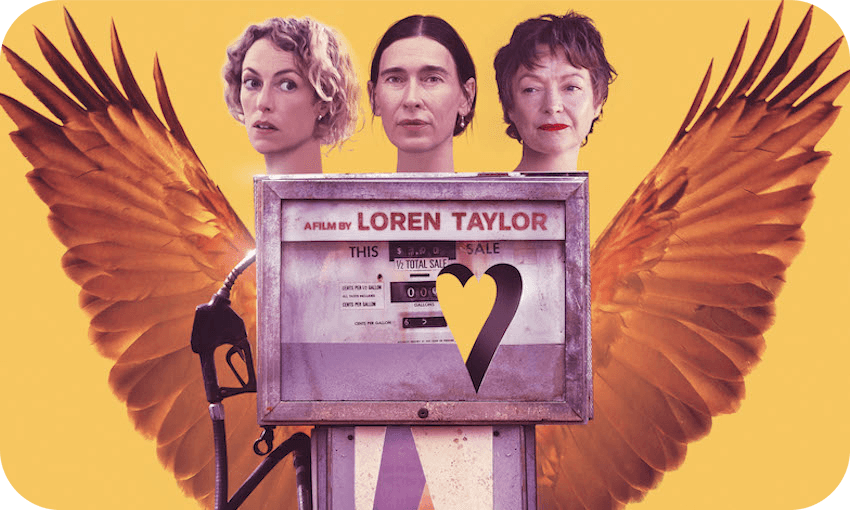Alex Casey talks to Loren Taylor, the writer, director and star of new film The Moon is Upside Down, about assembling her dream ensemble cast, toilet paper pads and turning literal dreams into reality.
There’s a moment in The Moon is Upside Down where frazzled anaesthetist Briar (Loren Taylor) gets her period on a road trip with her long-distance beau. Hastily winding toilet paper around her gusset in the toilet of a roadside tearoom, Taylor remembers a strong feeling of solidarity on set between the largely female crew. “They were like ‘this is so great – we’re not alone!’” she laughs. “It’s great to find company in those moments you know, that’s what art should be doing.”
As the writer, director and star of The Moon is Upside Down, the makeshift pad scene is just of many “deeply cathartic” moments that Taylor had while making the film. Following three women on very different journeys in the Wellington region, it’s an interwoven “existential cathartic dramedy” unlike anything this country has ever produced. There’s a mail-order bride adjusting to life in the wops, the aforementioned anaesthetist going camping with her long-distance beau, and a cashmere-touting landlord dealing with a tricky tenant (dead).
“I’d always loved multi-narrative films, the scale of them and the chance to use an ensemble cast,” Taylor explains. “It always looked like a really fun way to work.” And with a star-studded cast including the likes of Robyn Malcolm, Jemaine Clement, Robbie Magasiva, Elizabeth Hawthorne, Rachel House, Victoria Haralabidou and cameos from Ginette McDonald and Karen O’Leary, she might have just assembled the most powerful local ensemble of all time. “It was a total stroke of luck and sheer magic that they were all available.”
Many New Zealanders will remember Taylor for her role as Lily in Eagle vs Shark, the 2007 romantic comedy that she co-wrote with then partner Taika Waititi. Just as the film was being released in America, Taylor says her own life turned upside down. “I had to face up to some really major trauma stuff,” she says. “I was in this moment of massive creative momentum and I just got entirely taken out of it for about five years.” Following that, she was diagnosed with breast cancer in her 30s and had to undergo a mastectomy.
“Life threw a lot of big stuff at me,” she says. “It is wonderful to feel back in my creative swing now, because I wasn’t sure that it would ever happen again.”
The Moon Is Upside Down was inspired by everything from her sister’s short stories, to murmurs of a mail order bride in the Wairarapa, to Taylor’s own experiences. For example, the title. “When I first went overseas, it was the first thing that struck me – oh wow, the moon is upside down,” she says. “You just instantly get such a sense that we’re all on this ball spinning in space, and just how mysterious that all is.” Closer to home, Taylor also wanted to explore “soapbox stuff” around the housing crisis, industrial agriculture, and privilege.
Without giving away too many spoilers, the final jaw-dropping set piece of the film takes place on a spectacular piece of highway outside of Wainuiomata, and came directly from one of Taylor’s dreams. “I got really stuck on this story and didn’t know what to do with it,” she explains. “One night I dreamt that scene vividly, and the next morning I called one of my VFX friend at Wētā and was like ‘could we do this?’” With the green light, she was able to, quite literally, make her dreams a reality. “That was a very tingly day on set.”
Shot at breakneck speed in just 22 days with a $1.5million budget, there was another massive deadline looming. “I wanted to make the film quickly so I could finish it before I picked up my daughter and became a mum,” explains Taylor, who ended up travelling to Thailand to adopt her two-year-old daughter just five days after they finished filming in 2021. “It was really the worst possible possible timing you could hope for – becoming a mum to this two year-old little person while also putting a feature film together.”
The editing process was relegated to evenings, as the film slowly came together over the course of a year. “Our producers [Philippa Campbell and Georgina Allison Conder] are mothers too so we just worked together and found ways to do it.” Although not the most efficient process, the work paid off and in 2023, the film was awarded Best First Feature at Estonia’s Tallinn Black Nights film festival following sell-out screenings. “It was really amazing,” says Taylor. “The fact that some people out there have really got it feels awesome.”
While she’s aware that her self-described “existential cathartic dramedy” may not be to everyone’s tastes, Taylor’s hope is that people continue supporting New Zealand storytellers and enjoying the experience of seeing “ourselves and our country” on screen. And if you are planning on going to see The Moon Is Upside Down, Taylor has issued a deadline of her own. “Come in the opening weekend – otherwise the cinemas will give the screen back to Pixar or Marvel or The Fall Guy,” she laughs.
“Don’t let Ryan Gosling take our screens.”
The Moon is Upside Down is in cinemas nationwide from May 2.



